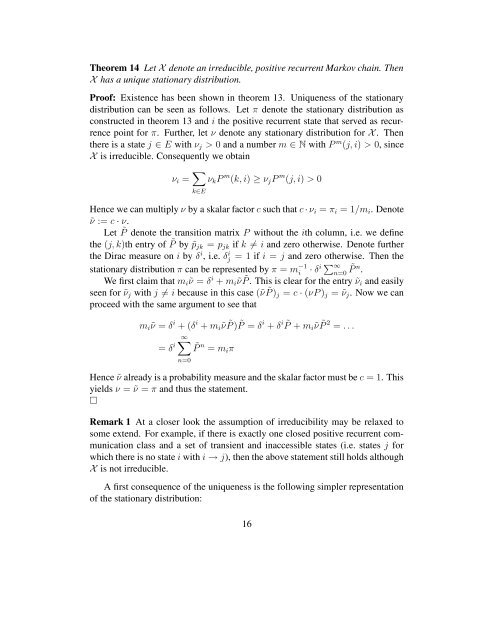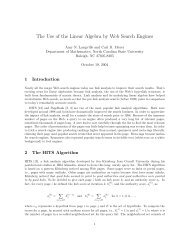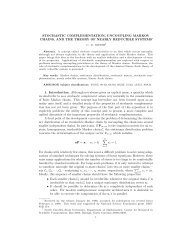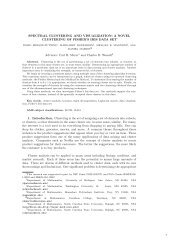Hui's reference material on Markov chains (pdf)
Hui's reference material on Markov chains (pdf)
Hui's reference material on Markov chains (pdf)
Create successful ePaper yourself
Turn your PDF publications into a flip-book with our unique Google optimized e-Paper software.
Theorem 14 Let X denote an irreducible, positive recurrent <strong>Markov</strong> chain. Then<br />
X has a unique stati<strong>on</strong>ary distributi<strong>on</strong>.<br />
Proof: Existence has been shown in theorem 13. Uniqueness of the stati<strong>on</strong>ary<br />
distributi<strong>on</strong> can be seen as follows. Let π denote the stati<strong>on</strong>ary distributi<strong>on</strong> as<br />
c<strong>on</strong>structed in theorem 13 and i the positive recurrent state that served as recurrence<br />
point for π. Further, let ν denote any stati<strong>on</strong>ary distributi<strong>on</strong> for X . Then<br />
there is a state j ∈ E with ν j > 0 and a number m ∈ N with P m (j, i) > 0, since<br />
X is irreducible. C<strong>on</strong>sequently we obtain<br />
ν i = ∑ k∈E<br />
ν k P m (k, i) ≥ ν j P m (j, i) > 0<br />
Hence we can multiply ν by a skalar factor c such that c · ν i = π i = 1/m i . Denote<br />
˜ν := c · ν.<br />
Let ˜P denote the transiti<strong>on</strong> matrix P without the ith column, i.e. we define<br />
the (j, k)th entry of ˜P by ˜p jk = p jk if k ≠ i and zero otherwise. Denote further<br />
the Dirac measure <strong>on</strong> i by δ i , i.e. δj i = 1 if i = j and zero otherwise. Then the<br />
stati<strong>on</strong>ary distributi<strong>on</strong> π can be represented by π = m −1<br />
i<br />
· δ i ∑ ∞<br />
n=0 ˜P n .<br />
We first claim that m i˜ν = δ i + m i˜ν ˜P . This is clear for the entry ˜ν i and easily<br />
seen for ˜ν j with j ≠ i because in this case (˜ν ˜P ) j = c · (νP ) j = ˜ν j . Now we can<br />
proceed with the same argument to see that<br />
m i˜ν = δ i + (δ i + m i˜ν ˜P ) ˜P = δ i + δ i ˜P + mi˜ν ˜P 2 = . . .<br />
∑ ∞<br />
= δ i ˜P n = m i π<br />
n=0<br />
Hence ˜ν already is a probability measure and the skalar factor must be c = 1. This<br />
yields ν = ˜ν = π and thus the statement.<br />
□<br />
Remark 1 At a closer look the assumpti<strong>on</strong> of irreducibility may be relaxed to<br />
some extend. For example, if there is exactly <strong>on</strong>e closed positive recurrent communicati<strong>on</strong><br />
class and a set of transient and inaccessible states (i.e. states j for<br />
which there is no state i with i → j), then the above statement still holds although<br />
X is not irreducible.<br />
A first c<strong>on</strong>sequence of the uniqueness is the following simpler representati<strong>on</strong><br />
of the stati<strong>on</strong>ary distributi<strong>on</strong>:<br />
16











